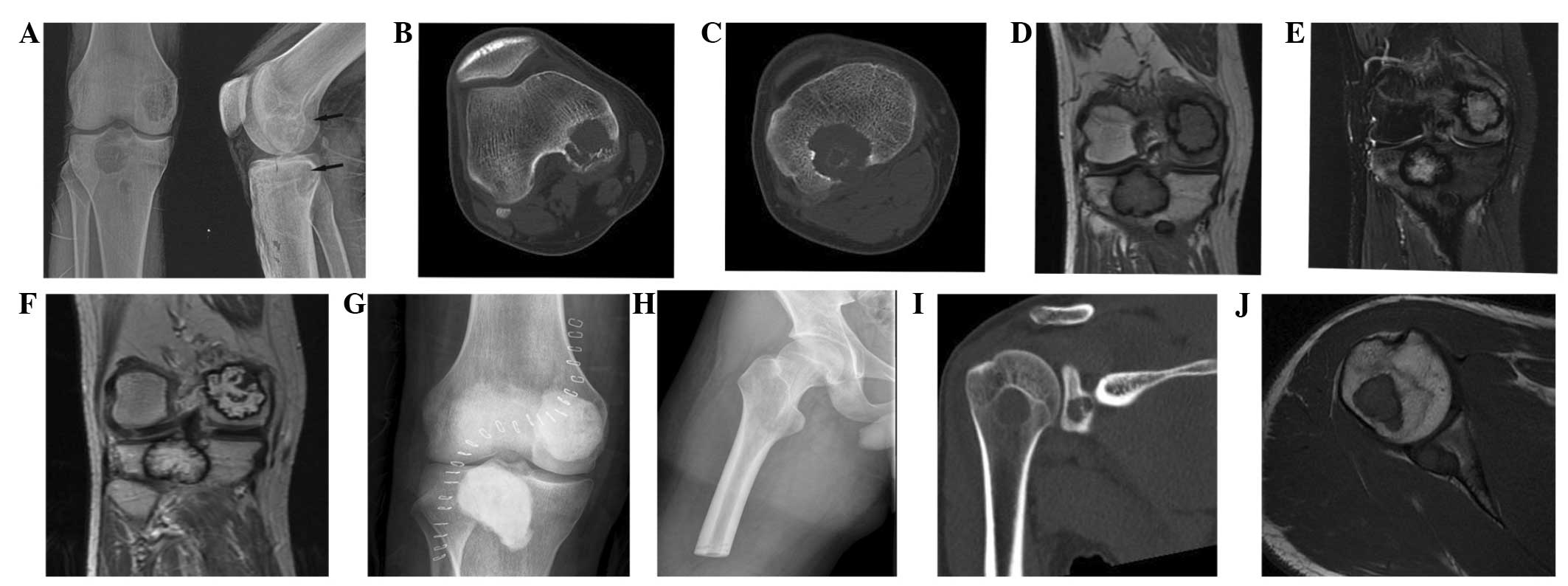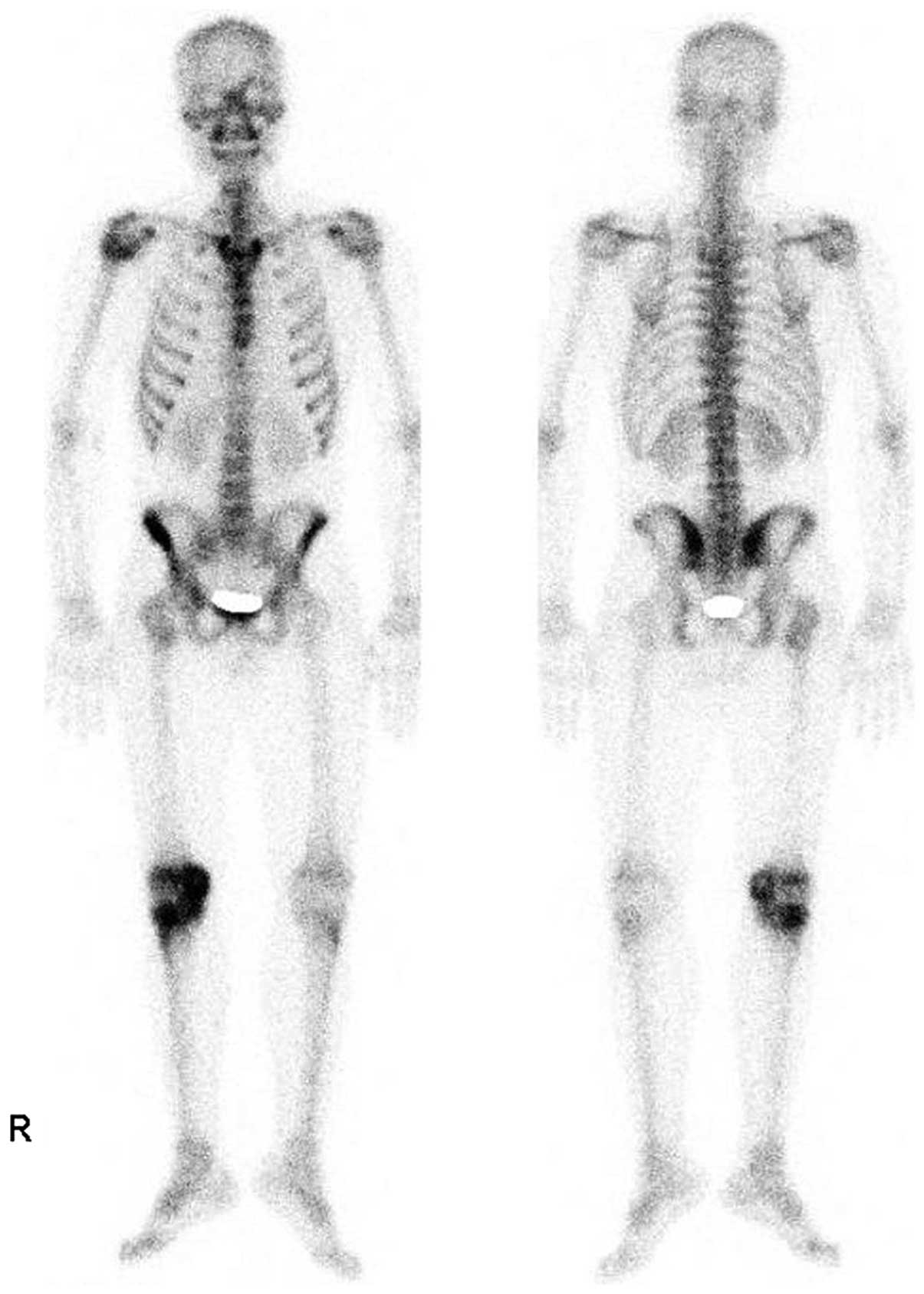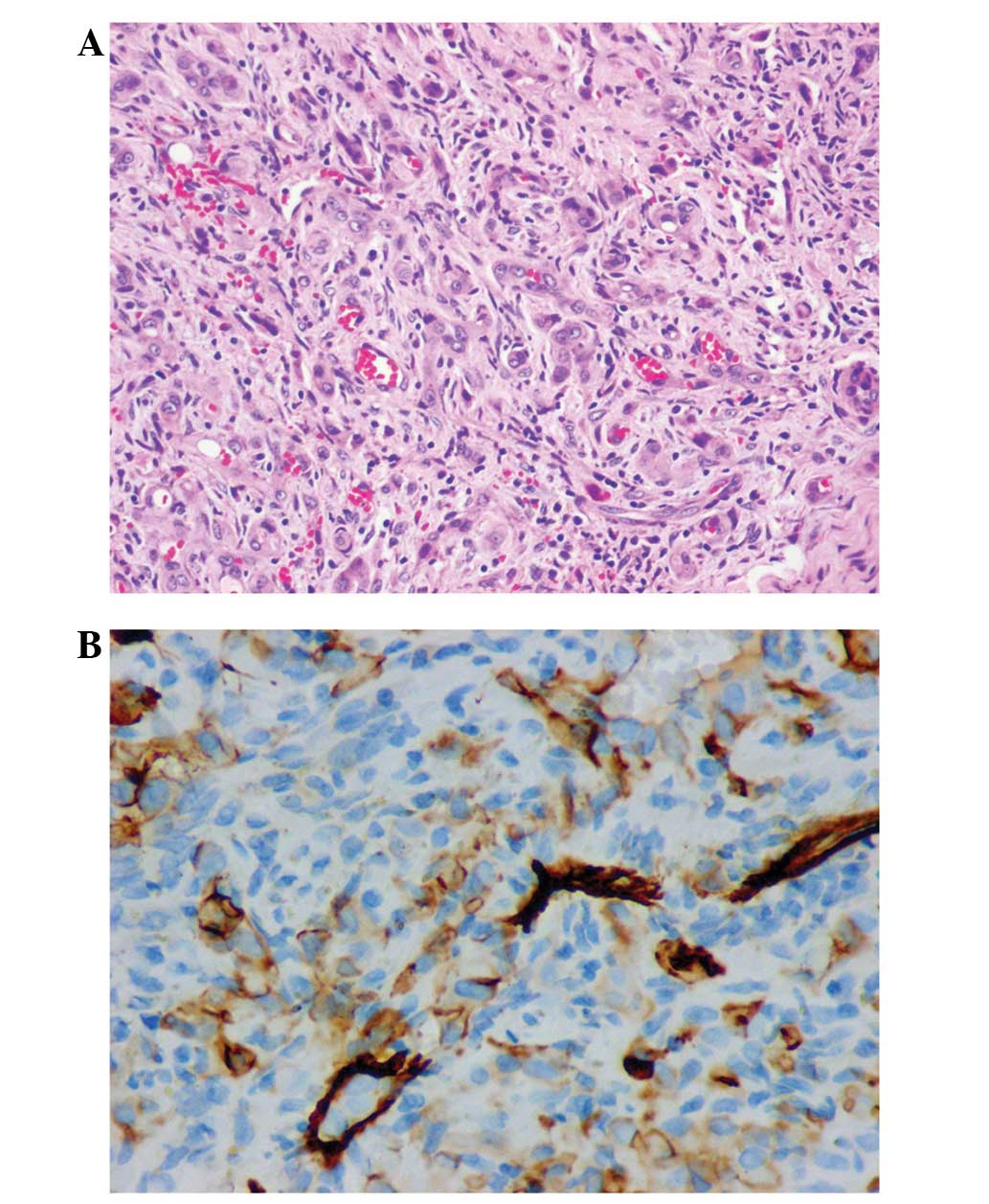Bone multicentric epithelioid hemangioendothelioma of the lower and upper extremities with pulmonary metastases: A case report
- Authors:
- Published online on: March 6, 2015 https://doi.org/10.3892/ol.2015.3018
- Pages: 2177-2180
Abstract
Introduction
Epithelioid hemangioendothelioma (EH) is a rare vasoformative tumor of intermediate-grade malignancy with a clinical course between hemangioma and angiosarcoma in terms of frequent local recurrences and metastatic potential (1). The tumor may occur in the soft tissues, liver, lungs and bone, as well as numerous other locations (2–5).
EH occurs less commonly in bone, accounting for <1% of all primary bone tumors. Mainly located in the long tubular bones of the lower extremities and pelvis, the tumor is rarely found in the upper extremities and flat bones (5–9). Therefore, the formation of a definitive diagnosis of EH is difficult and the tumor is easily misdiagnosed. Furthermore, the prognosis and treatment of EH remains controversial. The current study presents a rare case of multicentric EH of the right head of the humerus, scapula, ipsilateral distal femur and proximal tibia with visceral involvement of the lung, which was previously misdiagnosed as multiple chondroblastoma of the right distal femur and proximal tibia with low malignant potential. However, the diagnosis of EH was confirmed post-operatively by radiological and histopathological examination. Written informed consent was obtained from the patient.
Case report
In December 2012, a 20-year-old male patient presented to the orthopedics clinic at the Second Affiliated Hospital, School of Medicine, Zhejiang University (Zhejiang, China) with an increasing degree of pain in the right knee that had been apparent for eight months, predominantly whilst walking. The patient had no history of trauma or infection. Physical examination was normal, with the exception of the right knee, which was slightly enlarged, however, no soft-tissue swelling was identified.
As shown in Fig. 1A, plain radiography of the right knee revealed multiple large, lytic lesions with ill-defined margins in the medial femoral condyle and proximal tibia. Cortical destruction without periosteal reaction was also identified. However, no lesions of the chest were indicated on plain radiography.
Bone scintigraphy showed increased radionuclide uptake in the right medial femoral condyle and proximal tibia (Fig. 2). Slightly increased uptake in the right head of the humerus was also identified. However, no clinical symptoms, such as pain or swelling, were observed.
Non-enhanced computed tomography (CT) revealed multifocal eccentric lytic lesions in the medial femoral condyle and proximal tibia, with involvement of the medullar cavity and cortex (Fig. 1B and C).
Magnetic resonance imaging (MRI) of the right knee revealed multiple, large, irregular, nodular masses with intermediate intensity on T1-weighted images (Fig. 1D) and high signal intensity on T2-weighted images (Fig. 1E). The injection of gadolinium contrast material resulted in a high contrast enhancement and peripheral low signal intensity in all pulse sequences (Fig. 1F). The largest lesion in the proximal tibia was similar in size to that identified in the medial femoral condyle, which was ~3.5 cm in diameter. The masses were considered to arise from the medullary cavity, with destruction of the proximal cortex and extension into the adjacent soft tissue. The large lesions in the proximal tibia and medial femoral condyle were in close proximity to the articular surface, with a thin residual line of cortex. Furthermore, an edematous bone reaction was observed, which surrounded the lesions.
Initially, based on the radiological examination, the patient was diagnosed with multiple chondroblastoma of the right distal femur and proximal tibia, with low malignant potential. An extra-articular curettage of the lesions in the proximal tibia was performed and the medial femoral condyle was filled with bone cement (Fig. 1G).
However, following pathological examination, the tumor was diagnosed as an EH. Histopathological examination revealed that the tumor tissue was composed of solid nests and anastomosing cords of epithelioid cells with a moderate quantity of eosinophilic cytoplasm. The cells were variably spindle-shaped and epithelioid, with a number of intracytoplasmic vacuoles (Fig. 3A). The presence of intracytoplasmic vacuoles containing erythrocytes was considered as evidence of primitive vascular differentiation. In addition, rare mitotic figures and mild pleomorphism were identified. Immunohistochemistry revealed that the tumor cells were positive for vascular and stromal markers [cluster of differentiation (CD)34 (Fig. 3B), CD31 and vimentin] and negative for epithelial cytokeratin markers [epithelial membrane antigen (EMA) and AE1/AE3]. Following the diagnosis of EH based on the results of curettage, the patient underwent an amputation of the right leg at thigh level (Fig. 1H).
Following this second surgical procedure, whole-body MRI and CT scans were performed. As shown in Figs. 1I and J, multiple lytic lesions were identified in the right head of the humerus and scapula. Furthermore, CT scans of the chest and abdomen revealed pulmonary metastases. After consultation with orthopedic surgeons and radiotherapists, the patient underwent radiotherapy of the right head of the humerus and scapula, but refused chemotherapy. After the completion of radiotherapy treatment, monthly follow-up clinical examinations were performed for one year. Subsequently, follow-up telephone examinations were conducted every two months, which are ongoing. At the time of writing this manuscript, at 15 months post-surgery, the patient remains alive.
Discussion
EH is an intermediate-grade malignant vascular neoplasm, with a clinical course between those of epithelioid hemangioma and angiosarcoma (1). The first case of EH in the soft tissues was reported by Weiss and Enzinger in 1982 (10). Since then, a number of cases of EH have been reported in other locations, including the liver, lungs and bone. EH most commonly occurs in individuals between 20 and 30 years of age. EH of the bone is rare, with lesions distributed throughout the skeleton. Bone EH has a predilection for involvement of the axial skeleton and long tubular bones. Osseous EH may be observed as multifocal or multicentric lesions in a single bone or multiple bones; it predominantly occurs in the lower extremities and the pelvis, affecting the upper extremities, vertebrae and other flat bones less frequently. Simultaneous occurrence in the upper and lower extremities, as observed in the present case, is extremely rare (5–9,11). An extensive literature search of PubMed using the search terms, ‘epithelioid hemangioendothelioma’ ‘bone’, ‘multicentric’ and ‘multifocal’ revealed only one report of bone EH occurrence in the upper and lower extremities simultaneously. Boutin et al (5) reported a case involving several lesions, which were identified in the proximal and distal phalanges of the great toe, first metatarsal, medial cuneiform, tarsal navicular, C2 and C3 vertebral body, clavicle, scapulae and ilium. Due to the lack of literature regarding the simultaneous occurrence of bone EH in the upper and lower extremities, in the present case, the lesions identified on bone scintigraphy in the upper extremities were ignored until whole body MRI and CT scans were performed, even after the diagnosis with EH was verified post-operatively by histopathological examination.
Radiography and CT of EH usually reveals a lytic lesion without matrix mineralization that is localized in the medullary to cortical bone. Cortical disruption and joint invasion are also common features of EH. However, the signal characteristics on MRI are non-specific. Low to intermediate signal intensity on T1-weighted images and high signal intensity on T2-weighted images, with homogeneous enhancement, are identified following the injection of gadolinium-based contrast material (6,7,9). Detection of this tumor is difficult due to its rarity and uncharacteristic radiographic appearance (6,7). The differential diagnoses of multiple contiguous EH of the bone must include multifocal chondroblastoma, angiosarcoma and metastatic tumors. Chondroblastoma is a rare, benign tumor of the bone, which most frequently involves the epiphysis of the long bones, particularly the femur and tibia. Radiographs, on which chondroblastoma is difficult to differentiate from EH, show lytic expansile lesion with cortical disruption, and frequent encroachment of the articular cartilage. On MRI, the tumor exhibits a low signal on T1-weighted images, while T2-weighted images demonstrate high signal density components (12). Gadolinium-enhanced T1-weighted images exhibit strong contrast enhancement of the tumor (12). There have been several reported cases of multifocal chondroblastoma, which were considered as multiple primary lesions (12,13). Aggressive chondroblastoma with pulmonary metastasis is considered to be ‘malignant’ chondroblastoma (14). The term ‘aggressive’ chondroblastoma has been applied from a clinical point of view rather than as a histopathological entity. The present case was initially misdiagnosed as multiple chondroblastoma of the right distal femur and proximal tibia, based on the uncharacteristic radiographic appearance observed, and curettage of the lesions in the proximal tibia and medial femoral condyle was therefore performed.
A complete skeletal survey with bone scintigraphy is recommended prior to radiological diagnosis, as it may show undetected synchronous foci in completely separate anatomically sites. In the present report, bone scintigraphy showed slight increased radionuclide uptake in the right head of the humerus, but not in the right scapula. However, initially, the lesions in the right shoulder joint were ignored due to the lack of clinical symptoms. In addition to plain radiography and scintigraphy, MRI was performed in the present case, which revealed previously undetected lytic lesions in the right scapula. Notably, Camarero et al (15) identified no clear correlation between the radionuclide uptake and signal intensity on MRI for multicentric EH of the bone. Thus, CT may be the modality of choice for the evaluation of the thorax and exclusion of pulmonary metastases. In the present case, CT scans revealed pulmonary metastases of the tumor, which were initially missed on plain radiography of the chest.
Even with these specific radiological findings, the formation of a definitive diagnosis of EH is difficult when based on radiological findings alone. Therefore, the final diagnosis of EH requires histopathological analysis. EH exhibits diffuse and strong immunopositivity for vimentin and endothelial markers, such as CD31 and CD34, with no reactivity for epithelial markers. In the present case, the tumor cells were stained diffusely and intensely with antibodies to vimentin, and showed immunoreactivity for CD31 and CD34. No staining was observed with the AE1/AE3 and EMA epithelial markers.
Bone EH is a locally destructive tumor and its clinical course is unpredictable on the basis of histological features alone. Previous studies have indicated that multifocal EH may exhibit a better prognosis than unifocal EH, however, the pathogenesis remains controversial and the number of cases reported is limited (8,16). Various mechanisms have been described, including metastatic spread, malignant transformation and multifocal formation. It is difficult to identify whether a multicentric disease is primarily multicentric or whether it is a result of metastases from a primary unicentric tumor (16,17). Visceral involvement was reported to be the most important criterion in predicting a poor prognosis. Kleer et al (18) reported that 87.5% of EH patients with visceral involvement succumbed to the disease.
At present, no standard treatment for EH has been established. Although the majority of studies recommend radical wide surgical resection or amputation as the optimal treatment of multiple contiguous EH of the bone, (6,9) curettage is also an option (7,8). We believe that hemangioendothelioma has the potential to act aggressively and metastasize and thus recommend a wide surgical resection. At present, treatment plans should be tailored to the individual patient, according to the extent and location of the disease. In the present case, as curettage was initially performed for the treatment of chondroblastoma of the right distal femur and proximal tibia, an endoprosthetic replacement was not available and subsequently, an amputation of the right leg at thigh level had to be performed. In the present study, it was difficult to select an optimal treatment for the tumors in the right head of the humerus and scapula, as well as the lung, due to the widespread nature of the disease, which was identified by radiological examination. Radiation therapy may be administered alone or in combination with surgery, particularly for widespread metastatic tumors or unresectable lesions, as it has been shown to prevent local tumor progression (6). At present, the efficacy of chemotherapy has not been reported. Boutin et al (5) reported the case of one patient who experienced no tumor regression after chemotherapy treatment for a multicentric lesion. As a result, the patient in the present study selected radiotherapy treatment for the right head of humerus and scapula, but refused chemotherapy.
Bone multicentric EH is rare and must be distinguished from multifocal chondroblastoma, angiosarcoma and metastatic tumors. This report presents an extremely rare case of bone multicentric EH, involving the upper and lower extremities simultaneously. The results of this study may improve our understanding with regard to the clinical features of EH, as well as provide valuable insights for the accurate diagnosis, treatment and improved prognosis of patients with this disease.
Acknowledgements
This study was supported by the National Natural Science Foundation of China (grant no. 81301670) and the Specialized Research Fund for the Doctoral Program of Higher Education (grant no. 20110101120122).
References
|
Fletcher CDM, Unni KK and Merfens F: World Health Organization Classification of Tumors: Pathology and Genetics of Tumor of Soft Tissue and Bone. IARC Press; Lyon, France: pp. 173–175. 2002 | |
|
Bruegel M, Muenzel D, Waldt S, Specht K and Rummeny EJ: Hepatic epithelioid hemangioendothelioma: findings at CT and MRI including preliminary observations at diffusion-weighted echo-planar imaging. Abdom Imaging. 36:415–424. 2011. View Article : Google Scholar : PubMed/NCBI | |
|
Jinghong X and Lirong C: Pulmonary epithelioid hemangioendothelioma accompanied by bilateral multiple calcified nodules in lung. Diagn Pathol. 6:212011. View Article : Google Scholar : PubMed/NCBI | |
|
Deyrup AT, Tighiouart M, Montag AG and Weiss SW: Epithelioid hemangioendothelioma of soft tissue: a proposal for risk stratification based on 49 cases. Am J Surg Pathol. 32:924–927. 2008. View Article : Google Scholar : PubMed/NCBI | |
|
Boutin RD, Spaeth HJ, Mangalik A and Sell JJ: Epithelioid hemangioendothelioma of bone. Skeletal Radiol. 25:391–395. 1996. View Article : Google Scholar : PubMed/NCBI | |
|
Larochelle O, Périgny M, Lagacé R, Dion N and Giguère C: Best cases from the AFIP: epithelioid hemangioendothelioma of bone. Radiographics. 26:265–270. 2006. View Article : Google Scholar : PubMed/NCBI | |
|
Ignacio EA, Palmer KM, Mathur SC, Schwartz AM and Olan WJ: Epithelioid hemangioendothelioma of the lower extremity. Radiographics. 19:531–537. 1999. View Article : Google Scholar : PubMed/NCBI | |
|
Liu Q, Miao J, Lian K, Huang L and Ding Z: Multicentric epithelioid hemangioendothelioma involving the same lower extremity: a case report and review of literature. Int J Med Sci. 8:558–563. 2011. View Article : Google Scholar : PubMed/NCBI | |
|
Gosheger G, Hardes J, Ozaki T, Horst E, Bürger H and Winkelmann W: The multicentric epithelioid hemangioendothelioma of bone: a case example and review of the literature. J Cancer Res Clin Oncol. 128:11–18. 2002. View Article : Google Scholar : PubMed/NCBI | |
|
Weiss SW and Enzinger FM: Epithelioid hemangioendothelioma: a vascular tumor often mistaken for a carcinoma. Cancer. 50:970–981. 1982. View Article : Google Scholar : PubMed/NCBI | |
|
Gómez-Arellano LI, Ferrari-Carballo T and Domínguez-Malagón HR: Multicentric epithelioid hemangioendothelioma of bone. Report of a case with radiologic-pathologic correlation. Ann Diagn Pathol. 16:43–47. 2012. View Article : Google Scholar : PubMed/NCBI | |
|
Fukunaga M, Asanuma K and Irie T: Peculiar chondroblastoma involving multiple tarsal bones. Skeletal Radiol. 39:709–714. 2010. View Article : Google Scholar : PubMed/NCBI | |
|
Robetis PF and Talor JG: Multifocal benign chondroblastomas: report of a case. Hum Pathol. 11:296–298. 1980. View Article : Google Scholar : PubMed/NCBI | |
|
Elek EM, Grimer RJ, Mangham DC, Davies AM, Carter SR and Tillman RM: Malignant chondroblastoma of the os calcis. Sarcoma. 2:45–48. 1998. View Article : Google Scholar : PubMed/NCBI | |
|
Camarero A, Delgado M, Lorente R, Rayo JI and Ramos JL: Multicentric epithelioid hemangioendothelioma of bone: diagnostic imaging. Clin Nucl Med. 24:1002–1004. 1999. View Article : Google Scholar : PubMed/NCBI | |
|
Theurillat JP, Vavricka SR, Went P, Weishaupt D, Perren A, Leonard-Meier C and Bachli EB: Morphologic changes and altered gene expression in an epithelioid hemangioendothelioma during a ten-year course of disease. Pathol Res Pract. 199:165–170. 2003. View Article : Google Scholar : PubMed/NCBI | |
|
Evans HL, Raymond AK and Ayala AG: Vascular tumors of bone: A study of 17 cases other than ordinary hemangioma, with an evaluation of the relationship of hemangioendothelioma of bone to epithelioid hemangioma, epithelioid hemangioendothelioma and high-grade angiosarcoma. Hum Pathol. 34:680–689. 2003. View Article : Google Scholar : PubMed/NCBI | |
|
Kleer CG, Unni KK and McLeod RA: Epithelioid hemangioendothelioma of bone. Am J Surg Pathol. 20:1301–1311. 1996. View Article : Google Scholar : PubMed/NCBI |












